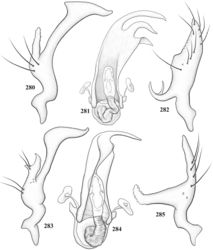Marinonicoris myrmecoides
| Notice: | This page is derived from the original publication listed below, whose author(s) should always be credited. Further contributors may edit and improve the content of this page and, consequently, need to be credited as well (see page history). Any assessment of factual correctness requires a careful review of the original article as well as of subsequent contributions.
If you are uncertain whether your planned contribution is correct or not, we suggest that you use the associated discussion page instead of editing the page directly. This page should be cited as follows (rationale):
Citation formats to copy and paste
BibTeX: @article{Henry2015ZooKeys, RIS/ Endnote: TY - JOUR Wikipedia/ Citizendium: <ref name="Henry2015ZooKeys">{{Citation See also the citation download page at the journal. |
Ordo: Hemiptera
Familia: Miridae
Genus: Marinonicoris
Name
Marinonicoris myrmecoides Carvalho – Wikispecies link – Pensoft Profile
- Marinonicoris myrmecoides Carvalho, 1988: 877 (orig. descrip.); Carvalho and Froeschner 1990[1]: 328 (type data, depository); Schuh 1995[2]: 141 (cat.); Carpintero et al. 2006[3]: 8 (list, distr.).
Diagnosis
This species (Figs 93, 94) is recognized by the generic characters, including the swollen pronotum, constricted hemelytra, the golden and silvery scale-like setae on the clavus and corium, the lack of erect, bristle-like dorsal setae, and the male genitalia, especially the parameres (Figs 280, 282).
Description
Male (n = 2): Length 2.98–3.36 mm, width 1.14–1.18 mm. Head: Width 0.72–0.77 mm, interocular width 0.30–0.34 mm. Labium: Imbedded in glue. Antenna: Segment I, length 0.16–0.21 mm; II, 0.51–0.58 mm; III, 0.30–0.37 mm; IV, 0.34–0.40 mm. Pronotum: Length 0.51–0.58 mm, basal width 0.91–1.04 mm.
Coloration: Head: yellow brown to dark brown. Antenna: Segment I yellowish brown, with a red streak on inner margin; segments II–IV dark brown. Pronotum: Dark brown, area around calli sometimes slightly paler brown. Scutellum: Brown. Hemelytron: Dark brown, area on basal half of corium and clavus appearing paler brown because of setal coloration. Ventral surface: Thoracic area yellowish brown, mesopleural area with a glaucous sheen; abdomen dark brown to fuscous, glaucous stridulatory patch distinct. Ostiolar evaporative area: Dark brown, with a red knob at middle of auricle. Legs: Dark brown, apices of hind femora and tibiae and all of tarsi and claws pale yellowish brown.
Structure, texture, and vestiture: As in generic description. Head, pronotum, and hemelytra shiny. Labium: Extending about to hind coxae or base of abdomen. Each hemelytron with two rows of silvery scale-like setae, one across the base of the corium and clavus, and one across the middle of the corium and apex of the clavus; area between densely covered with golden scale-like setae (but lacking erect, bristle-like setae).
Male genitalia: Left paramere (Fig. 280): Elongate, distal stem-like, with beak-like apex elongate, basal half stouter with a short, slender, apically rounded arm. Right paramere (Fig. 282): Stout, with a slender, apically bifid arm near base. Phallotheca (Fig. 281): Stout, apex with three comb-like processes.
Female (n = 4): Length 2.62–2.98 mm, width 1.02–1.18 mm. Head: Width 0.70–0.72 mm, interocular width 0.30–0.35 mm. Labium: Imbedded in glue. Antenna: Segment I, length 0.16–0.18 mm; II, 0.50–0.53 mm; III, 0.55 (others missing) mm; IV missing. Pronotum: Length 1.00–1.03 mm, basal width 0.80–0.91 mm. Similar to male in color, texture, and vestiture.
Distribution
Previously known only from the holotype taken in Paraná, Brazil. Carpintero et al. (2006)[3] reported specimens from Argentina, Paraguay, and Uruguay. Rio Grande Norte is a new Brazilian state record.
Host
Unknown.
Discussion
The holotype, though not borrowed, was examined during a visit to the Museu Nacional collection (MNHN) in Rio de Janeiro. This species is easily distinguished by the structure of the male genitalia.
Type material examined
Holotype ♂, BRAZIL: Paraná: Telêmaco Borba, Reserva Samuel Kalbin, [24.35ES 50.6167EW], 669 m, 02 Nov 1986, Lev. Ent. Profau Par, lâmpada (00175020) (MNRJ).
Other specimens examined
ARGENTINA: Chaco: Fontana, Unknown, 1♀ (00071514) (USNM); 1♂, Martin Garcia Isl., Buenos Aires Prov., Nov. 96, M. C. Coscarón (MACN); 1♂, Arroya Martires, Misiones, Aug. 1995, D. L.Carpintero (MACN); 1♀, Corrientes Prov., Bella Vista, June 1936 (MACN). BRAZIL: Sao Paulo: Piracicaba, 22.73931ES 47.655EW, Unknown, 1♀ (00071513) (USNM). 1♂, Natal, Rio Grand Norte, Feb. 1952, M. Alvarenga (MNHN). PARAGUAY: 1♂, Arroya Aguapey, Mar. 1994, D. L. Carpintero (MACN). URUGUAY: 1♀, Rivera Dept., Sierra and Arroya de al Aurora, 12 Jan. 1971 (MACN).
Taxon Treatment
- Henry, T; 2015: Revision of the Ceratocapsine Renodaeus group: Marinonicoris, Pilophoropsis, Renodaeus, and Zanchisme, with descriptions of four new genera (Heteroptera, Miridae, Orthotylinae) ZooKeys, (490): 1-156. doi
Images
|
Other References
- ↑ Carvalho J, Froeschner R (1990) Taxonomic names proposed in the insect order Heteroptera by José Candido de Melo Carvalho from January 1985 to January 1989, with type depositories. Journal of the New York Entomological Society 98: 310–346.
- ↑ Schuh R (1995) Plant Bugs of the World (Insecta: Heteroptera: Miridae). Systematic catalog, distributions, host list, and bibliography. New York Entomological Society, New York, 1329 pp.
- ↑ 3.0 3.1 Carpinterio D, Dellapé P, Melo M (2006) New records of Heteroptera (Hemiptera) from Argentina. Zootaxa 1129: 1–22.

